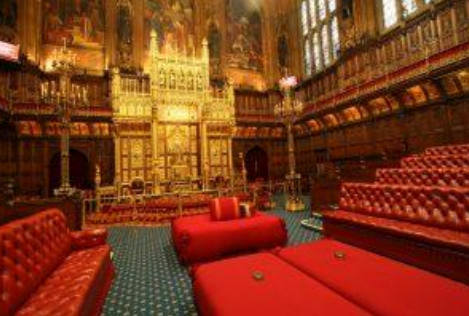.

Our picture shows the Chamber of the House of Lords which is dominated by the Royal Throne. It was designed by A.W. Pugin for ceremonial use, and – in particular – for the official opening of the House of Lords in April 1847.
Picture Credit: https://victorian-era.org/history-westminster-palace.html
OVER THE last few months, we’ve been looking at the existence & purpose of the House of Lords.
We accept and understand why it was founded. And that’s to provide a vital counterbalance to the House of Commons. A series of checks and balances are a good idea when applied to many aspects of life (such as business and finance). But this is particularly so of politics & especially when the government of the day has an overwhelming majority.
However, it’s clear that the mere existence of the House of Lords remains a bone of contention for many people.
SUPPORT THE HOUSE OF LORDS
We’ve previously examined the arguments those who support the House of Lords and its workings.
In particular, they highlight the valuable role it plays in scrutinising legislation (which has previously been passed in the Commons).
However, they also acknowledge that the debate over whether to reform – or even abolish – the House of Lords often reflects broader philosophical discussions. These discussions revolve around tradition versus modernisation and meritocracy versus aristocracy.
We feel that many of those who support the House of Lords as it stands are culturally very conservative (almost to the point of absurdity). They favour tradition & aristocracy over everything else.
OPPOSE THE HOUSE OF LORDS
We’ve also looked at the arguments of those who criticise & oppose the Lords.
In a nutshell, they claim that it is an outdated and undemocratic institution. In particular, they point to the presence of hereditary peers as evidence of elitism and inherited privilege.
With the above in mind, we now look at some of the potential reforms relating to the House of Lords:
Elected Senate. One of the most proposed reforms is the creation of an elected Senate. This would replace hereditary and appointed peers with elected representatives. Supporters claim that this would ensure that the upper chamber has democratic legitimacy.
An elected Senate could be structured similarly to other bicameral systems (1) around the world. Here, members could be elected via proportional representation (PR) or the current First Past The Post (FPRP) system.
Supporters claim that having elected representatives – as opposed to hereditary peers – would enhance accountability. Additionally, the legislative process would be more reflective of the electorate’s will.
Non-Partisan Appointments. Another popular alternative is to reform the appointment process for the upper chamber, focusing on non-partisan appointments.
This approach would involve creating an independent commission responsible for appointing members based on their expertise and contribution to society, rather than political affiliation.
The goal would be to retain the benefits of having knowledgeable and experienced individuals while eliminating the influence of political patronage and hereditary privilege.
Non-partisan appointments could ensure that the chamber remains a source of expert advice and thorough legislative scrutiny.
Reforming Hereditary Peerage. Instead of abolishing the House of Lords entirely, some propose reforming the hereditary peerage system. This could involve gradually phasing out hereditary peers and replacing them with life peers or elected members.
Existing hereditary peers could be allowed to serve out their terms, but no new hereditary titles would be granted. This approach would mitigate the undemocratic aspects of inherited privilege while maintaining the institution’s historical continuity and tradition.
• To be continued.
(1) A bicameral system refers to a legislative body that is divided into two separate chambers or houses. Typically, these two chambers are known as the lower house and the upper house. Each chamber may have different responsibilities, powers, and methods for selecting its members. The term bicameral comes from the Latin words bi meaning ‘two’ and camera meaning ‘chamber.’
In countries with a bicameral legislature, the two houses work together to review, amend, and pass legislation. The intention is often to provide a system of checks and balances, ensuring that laws are carefully considered from different perspectives before becoming official.
For example, like the UK, the United States Congress is bicameral, comprising the House of Representatives and the Senate.
• THIS ARTICLE should be read in conjunction with the following:
The House Of Lords – Should It Stay Or Should It Go? Part 5
































